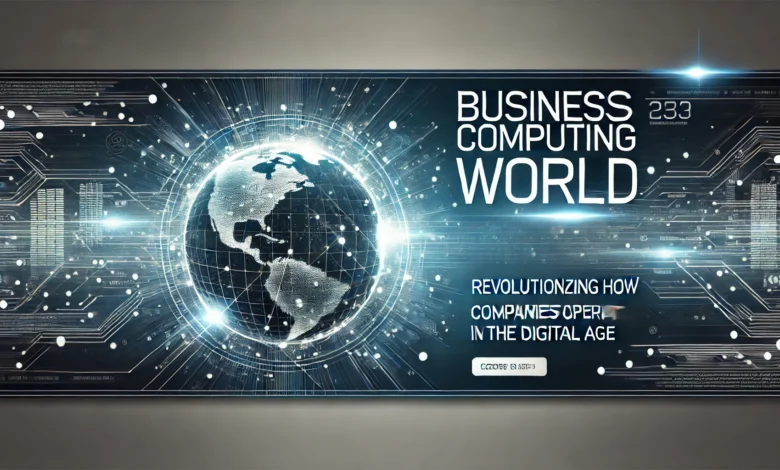Business Computing World: How Technology is Reshaping the Way Companies Work

Introduction to the Business Computing World
Business Computing World The phrase “business computing world” might sound like a buzzword at first, but it’s actually a practical way to describe how technology, data, and digital systems have become the backbone of modern businesses. Whether you’re a small startup or a multinational corporation, computing isn’t just something happening in the IT department anymore—it’s at the very core of decision-making, growth strategies, and day-to-day operations.
Think about it. From accounting software and customer relationship management (CRM) tools to cloud services and artificial intelligence, computing powers almost every function in today’s organizations. The business computing world isn’t just about having the latest gadgets or flashy software; it’s about leveraging these tools to improve efficiency, make smarter decisions, and stay competitive in an increasingly digital marketplace.
In fact, businesses that ignore the role of computing are almost guaranteed to fall behind. Technology moves quickly, and companies that don’t adapt often struggle to survive. On the flip side, those who embrace computing solutions effectively tend to be the ones leading their industries, scaling faster, and attracting the best talent.
The Evolution of Business Computing
Computing in business didn’t start with cloud servers and AI—it goes way back. Early on, businesses used mainframe computers to handle massive amounts of data processing. These machines were expensive and limited to large corporations, but they represented the foundation of what we now call business computing.
By the 1980s and 1990s, personal computers became common in offices. This shift revolutionized how employees worked. Suddenly, spreadsheets, databases, and word processing tools were accessible to almost anyone. This democratization of technology changed the pace of business forever. Managers could generate reports instantly, employees could collaborate more easily, and small businesses started competing with larger firms thanks to affordable computing power.
Fast forward to today, and we’re living in a hyper-connected era. Cloud computing has removed the limitations of physical servers, mobile devices have blurred the line between office and home, and AI-driven analytics help businesses make sense of complex data. This constant evolution shows that the business computing world is never static—it adapts and grows with the needs of the modern workforce.
Core Components of Business Computing

When we talk about the business computing world, it’s helpful to break it down into its core components. These are the technologies and systems that businesses rely on every single day.
Hardware and Infrastructure
Every computing world starts with hardware—servers, laptops, mobile devices, and networking systems. Even in an age of cloud dominance, companies still need robust hardware to connect employees, secure data, and ensure smooth operations. For some businesses, investing in high-performance infrastructure is non-negotiable, especially in industries like finance or healthcare where downtime isn’t an option.
Software and Applications
Software is where the real magic happens. From accounting software like QuickBooks to advanced ERP (Enterprise Resource Planning) systems, applications are what turn raw computing power into business value. Today, cloud-based software dominates, offering flexibility, scalability, and accessibility. Tools like Microsoft 365, Salesforce, and Slack have become household names in the business computing world.
Data and Analytics
Data is often called the “new oil,” and in business computing, that’s not an exaggeration. Companies generate vast amounts of data daily, from customer interactions to supply chain operations. Analytics tools help make sense of this information, uncovering patterns, predicting trends, and guiding decision-making. Without data-driven insights, businesses would essentially be operating blind in today’s competitive markets.
The Role of Cloud Computing in Modern Business
One of the biggest shifts in the business computing world has been the rise of cloud computing. The cloud has completely changed how businesses store, access, and manage their information. Instead of relying on bulky in-house servers, companies can now use cloud services that scale with their needs.
Cloud solutions offer more than just storage. They enable collaboration across continents, remote working, and real-time access to applications. This became especially important during the global shift to remote work, where cloud services kept businesses running even when employees were miles apart.
Another big advantage of the cloud is cost efficiency. Small businesses can now access enterprise-level computing resources without needing to spend millions on infrastructure. Pay-as-you-go models make it easier to budget, and companies can quickly scale up or down depending on demand.
Security has always been a concern with the cloud, but providers have invested heavily in making their platforms secure. Today, many cloud services are safer than traditional on-premises solutions, thanks to advanced encryption, regular security updates, and compliance certifications.
Artificial Intelligence and the Future of Business Computing
Artificial intelligence (AI) is no longer science fiction—it’s at the center of the business computing world. From chatbots handling customer service queries to machine learning algorithms predicting consumer behavior, AI is transforming how companies operate.
One of the most impactful uses of AI is in automation. Repetitive tasks that once required human effort—like sorting through emails, managing schedules, or analyzing spreadsheets—can now be handled by AI systems. This frees up employees to focus on higher-value work, boosting productivity across the board.
AI also plays a major role in personalization. Think about e-commerce platforms that recommend products based on your browsing history. Those suggestions are powered by AI, and they directly impact sales and customer satisfaction. Businesses that adopt AI-driven personalization are often able to create stronger customer loyalty and increase revenues significantly.
Looking ahead, AI will continue to expand its footprint in the business computing world. Predictive analytics, natural language processing, and advanced robotics are just the beginning. Companies that invest in AI today are essentially building a future-proof strategy.
Challenges in the Business Computing World
Of course, it’s not all smooth sailing. As with any major shift, the growing role of computing in business comes with its own set of challenges.
Cybersecurity Risks
The more companies depend on computing systems, the more attractive they become to cybercriminals. Data breaches, ransomware attacks, and phishing scams are real threats that can cripple even the most established businesses. That’s why cybersecurity is a top priority in the business computing world.
Cost and Implementation
While computing can save money in the long run, the initial costs of new systems, training, and integration can be overwhelming—especially for small businesses. Not every company has the resources to implement complex computing solutions, and poor implementation can actually hurt productivity instead of helping it.
Keeping Up with Rapid Change
Technology evolves faster than most companies can adapt. New tools and platforms appear every year, and staying up to date can be exhausting. Businesses often struggle with knowing when to adopt new technologies and when to stick with what they have. Falling too far behind, however, can mean losing out to more tech-savvy competitors.
Why the Business Computing World Matters More Than Ever
At its core, the business computing world is about empowering businesses to thrive in a digital-first environment. It’s not just about technology for technology’s sake—it’s about solving real-world problems, improving efficiency, and creating better experiences for both employees and customers.
Think about how businesses operated twenty years ago compared to today. Communication was slower, decision-making relied heavily on gut instinct, and scaling a company took years. Now, thanks to computing, communication is instant, decisions are data-driven, and scaling can happen in months rather than decades.
The companies that succeed today are the ones that understand this shift and embrace computing as a core part of their strategy. In many ways, the business computing world is no longer optional—it’s essential.
Conclusion: Embracing the Digital Future
The business computing world is a vast, ever-changing landscape, and it’s only becoming more important as technology advances. From hardware and cloud systems to AI and cybersecurity, computing touches every part of modern business life.
For leaders, the challenge is clear: adapt or get left behind. Those who embrace business computing not only survive but thrive, creating innovative solutions, connecting with customers more effectively, and staying ahead of the curve.
The bottom line? The business computing world isn’t just a trend—it’s the foundation of the future of work. And whether you’re running a small local shop or a multinational corporation, understanding and investing in it could be the smartest business decision you’ll ever make.
